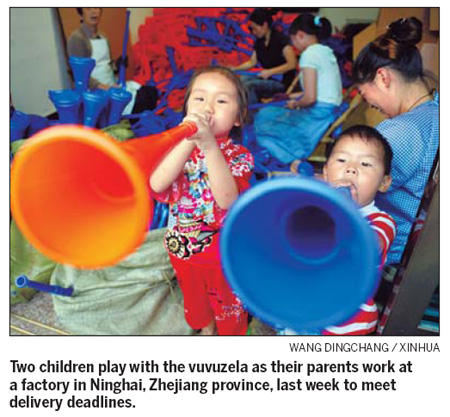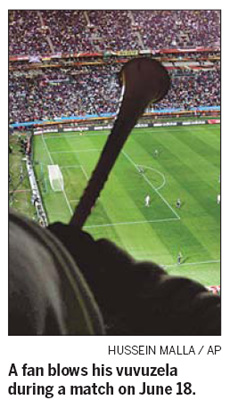InfoGraphic
Call of the VUVUZELA
By Hu Yongqi (China Daily)
Updated: 2010-06-30 11:29
 |
Large Medium Small |

 Soccer fanatic Huang Xile has been so busy with work recently he has seen almost none of the action at the FIFA World Cup. It is perhaps just a little ironic that his job is making vuvuzelas, the cacophonic horns that have proven so popular with fans in South Africa this year.
Soccer fanatic Huang Xile has been so busy with work recently he has seen almost none of the action at the FIFA World Cup. It is perhaps just a little ironic that his job is making vuvuzelas, the cacophonic horns that have proven so popular with fans in South Africa this year.
About 90 percent of all vuvuzelas at the matches have been made in China, with most produced at four factories in Shantou, Guangdong province, and one in Yiwu, Zhejiang province.
"All these horns will head to South Africa," said Huang, owner of the Fengxiang Litong Plastic Toy Factory in Shantou's Chenghai district, as he showed a new recruit how to work a plastic molding machine.
"I've had no spare time to watch this year's World Cup," he said. "It's not that I'm solely focused on the profits but I need to ship the products on time."
Although there is no official figure available on how many vuvuzelas have been exported by Chinese firms to Africa, staff with Chenghai Toy Association said the market is "conservatively estimated" to be worth about $20 million.
Huang's workshop has a registered capital of 300,000 yuan ($44,000) and hires 100 employees, but it makes about 2 million yuan in annual revenue.
"We've made about 1 million vuvuzelas for South Africa," said the boss, who began to expand his workforce - mainly migrants from Henan province - after receiving several large orders for the horns in January.
Originally used to drive away baboons on the African continent, the vuvuzela is a long, straight horn that blares a monotone note of up to 127 decibels.
Before the opening ceremony of the finals on June 11, pundits tipped the instrument to be one of the talking points of the tournament. And they were right. Love them or hate them, it has been impossible to enjoy a game this year without having to endure a never-ending chorus of vuvuzelas (the sound resembles a large swarm of bees).
While some supporters have complained the horns are too noisy, Chinese fans see the vuvuzela as a connection with a tournament their national team failed to qualify for.
|
||||
However, despite the large volume of production in China, the vuvuzela market is still small potatoes to toy manufacturers.
Of the three factories contacted by China Daily in Chenghai, an area 20 km from Shantou's downtown, all were small- and medium-sized enterprises (SMEs), and managers said profit margins were extremely low.
Each plastic horn, which are 76 cm in length, costs just 2.8 yuan wholesale, bringing an individual profit of just 4 jiao (there are 10 jiao in 1 yuan).
"The low profit margin means I can't sell directly to customers (off the street)," said the owner of another Chenghai toy factory surnamed Chen, who did not want his full name used. "We won't take an order unless the buyer needs at least 5,000 horns. Otherwise, I will suffer a loss instead of making money to feed my workers."
It usually takes experienced workers 10 days to make and deliver 10,000 vuvuzelas, said Chen, whose five-story plant is buried deep in the district's Fengxiang Industrial Park.
"The process (of making a vuvuzela) is very easy," he said. "Workers just pour raw plastics into a mold and take the horn out when it cools and solidifies."



